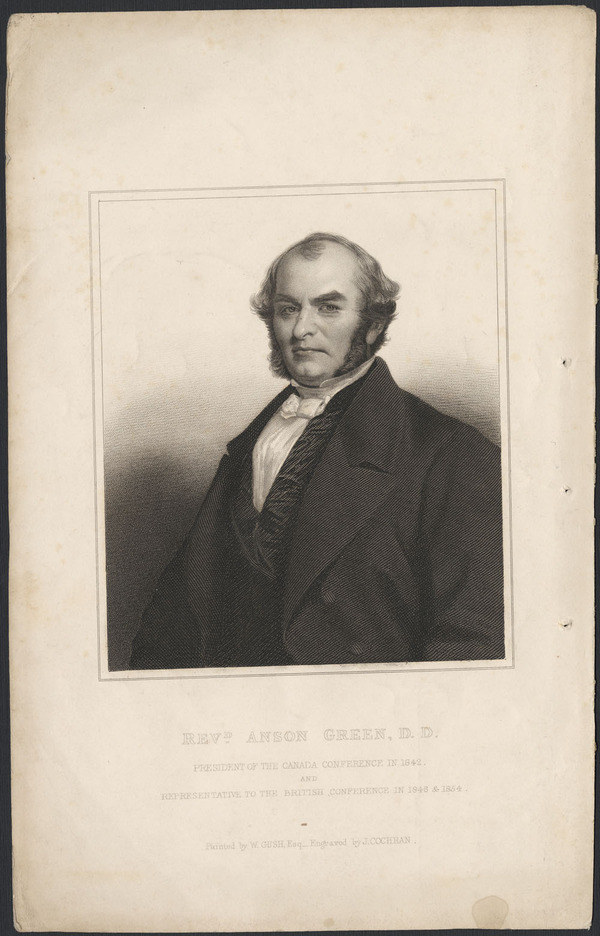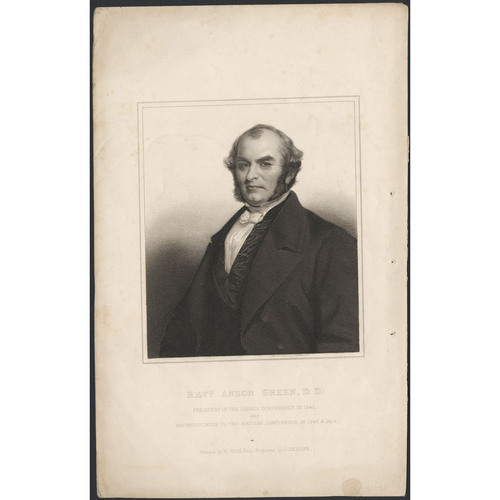GREEN, ANSON, Methodist clergyman; b. 27 Sept. 1801 at Middleburgh, Schoharie County, New York, one of a large family born to Joseph Green and Lydia Vorce; d. 19 Feb. 1879 at Toronto, Ont.
Anson Green was raised on the family farm in the Catskills and sent to school for only a short period each year. He had little interest in religion until his mother died in 1816 and he was seriously ill for several months in 1818. He was then led to read the Scriptures and attend prayer meetings, and to a growing conviction of personal sin. In 1819, after he had discovered his brother praying privately in a field for his conversion, Green passed through a spiritual crisis. He felt that his burden of guilt had been removed and he soon joined the Methodist Episcopal Church and was licensed as an exhorter.
Green came to Upper Canada in 1823 while en route to Ohio, decided to remain, and, although largely self-educated, obtained a teaching post at West Lake in Prince Edward County. He was licensed to preach in 1824 by the Canada Conference of the Methodist Episcopal Church and was received into the ministry on trial the next year. He was ordained deacon in 1827 and elder in 1830. In 1828 he had married Rachel, second daughter of Caleb Hopkins, a Reform politician who was later a founding member of the Clear Grit party.
As a saddle-bag parson responsible for a 400 mile frontier circuit, Green preached on an average of once a day. Methodist itinerants were posted to different circuits at least every second year but most of Green’s early circuits were in the eastern Lake Ontario–upper St Lawrence region. Green soon earned the reputation of being a fiery preacher, but he also displayed administrative talents which quickly led to his promotion to positions of authority within his church. From 1832 to 1835 he was chairman of the Augusta District in eastern Upper Canada and, from 1836 to 1839, chairman of the Bay of Quinte District. He left this area in 1839 and until 1844 was chairman, first of the Toronto District, later of the Hamilton District, before returning to the Toronto District.
In 1833 the Canadian conference of the Methodist Episcopal Church had united with the more conservative British Wesleyan Methodist Church (this name being retained), at the instigation and with the financial encouragement of the Colonial Office and the Upper Canadian government [see Robert Alder]. However, many members of the British conference disapproved of the voluntaryism and liberal political sentiments of their Canadian colleagues, particularly as publicly expressed by Egerton Ryerson*, and the union was dissolved in 1840. Some of the Canadian itinerants went to the British body, but Green remained with the Wesleyan Methodist Church in Canada.
Green deplored the disruption of 1840, however. When he was elected president of the Canadian conference in 1842, after having been secretary in the previous year, he and John Ryerson were sent to New York to seek the aid of the American Episcopal Church in healing the breach. They were unsuccessful, but in 1846, when Green went to England with John Ryerson to attend the meeting which resulted in the formation of the Evangelical Alliance, they also formulated the terms which led to the reunion of the Canadian and British churches in 1847.
Green also played a prominent part in promoting the union of the several Methodist denominations in Canada. He was active in the events that led to union of the Wesleyan Methodist conferences of Canada East and Canada West in 1855. He served on a joint committee from 1871 to 1874 when the union of the Canadian Wesleyan Methodist Church, the Methodist New Connexion Church, and the Wesleyan Methodist Church in Eastern British North America was effected.
In 1844 Green had succeeded Alexander McNab as steward of the conference Book Room and printing establishment (later the United Church Publishing House and its subsidiary, the Ryerson Press) in Toronto, an appointment that marked his effective separation from circuit work and his entry into the central administrative offices of the church. He expanded the operations of the Book Room by making a highly favourable trade arrangement for books with the American conference’s Book Room in 1848 and by opening a branch in Montreal in 1849. He also introduced the first steam newspaper press to Canada in 1851 for the use of the Methodists’ weekly, the Christian Guardian.
Green was concerned with regularizing the institutional life of the church. He was responsible for the incorporation in 1851 of the Wesleyan Methodist Church in Canada and of its Book Room, Annuitant Society, and Superannuation Fund Society. He was involved in the reorganization of the church’s temporalities in 1855 when the conference provided increased pecuniary benefits to its preachers. It was also resolved at this conference to appoint equal numbers of laymen and preachers to all committees dealing with finance, the first time laymen were given a role in the government of the Canadian Wesleyan Methodist Church. Green was also named chairman of the church’s Board of Superannuation.
Although he himself was superannuated in 1855, Green returned to service in 1856 as a delegate to the British conference, and supervised the transfer of the Methodist missions in the north-west to Canadian jurisdiction. He served as book steward from 1859 to 1862 and in 1864, and he became, in 1863, the first Canadian to be appointed president of the Canadian conference by the British conference under the terms of the 1847 union. He was again placed on the superannuated roll in 1865.
Green had a long connection with Victoria College, particularly with its financial administration. As chairman of the Bay of Quinte District in 1836 he had presided at the opening of the conference’s educational institution, the Upper Canada Academy at Cobourg. As treasurer and member of the academy’s managing committee he negotiated with Lieutenant Governor Sir Francis Bond Head for the payment of the royal grant. When the academy was reopened as Victoria College in 1841 to teach university subjects, Green was chairman of the college board and delivered the address at the installation of its first principal, his friend Egerton Ryerson. In 1858 he became bursar of the college and in 1860 appeared along with Samuel Sobieski Nelles* and Joseph Stinson* before a parliamentary committee which was investigating the claims of denominational colleges to share in the provincial university endowment. In 1868 he was secretary of a joint committee of Queen’s University at Kingston and Victoria College, appointed to study the questions of their finances and their proposed affiliation to the University of Toronto.
Over a period of years Green was active in a variety of social and religious agencies, including the provincial asylum and the Toronto House of Industry; he helped organize Canadian Indian and Japanese missions, build Toronto’s Metropolitan Methodist Church, and found the Dominion Evangelical Alliance.
In an age when the laity played little part in the government of the Wesleyan Methodist Church, Green acquired a reputation among his fellow clergy of being a successful seeker of offices of power. In every position he occupied he showed managerial talents of a high order and seemed to achieve satisfaction through controlling much of the inner operations of the church rather than in creating a public image as a prominent preacher. In addition to having been three times a delegate to both the English and the American conferences and twice president of the Canadian conference, he held virtually every senior administrative post in his church and served on many of its committees.
Anson Green died in Toronto in 1879 and was survived by his widow and one son, Columbus H. Green, a barrister. His married daughter, Eliza, had died in 1863. Green’s autobiography refers in the 1870s to a son, Anson, but this may have been a family name for Columbus.
[Anson Green wrote his autobiography, The life and times of the Rev. Anson Green, D.D. . . . (Toronto, 1877), at the request of the Canadian Wesleyan Methodist Conference. The book is both readable and reliable, but the personal papers on which it was obviously based do not appear to have survived. A few of his letters are in the A. E. Ryerson papers at the United Church of Canada Archives, Toronto, and have been quoted in Sissons, Ryerson.
Christian Guardian (Toronto), 26 Feb. 1879. The minutes of the annual conferences of the Wesleyan Methodist Church in Canada, from 1824 to 1857 (2v., Toronto, 1846–63). [A. E. Ryerson], My dearest Sophie, letters from Egerton Ryerson to his daughter, ed. C. B. Sissons (Toronto, 1955). Cornish, Cyclopædia of Methodism, I. Carroll, Case and his cotemporaries. The chronicle of a century, 1829–1929, the record of one hundred years of progress in the publishing concerns of the Methodist, Presbyterian, and Congregational churches in Canada, ed. Lorne Pierce (Toronto, 1929), 78–85. j.s.m.]
Cite This Article
John S. Moir, “GREEN, ANSON,” in Dictionary of Canadian Biography, vol. 10, University of Toronto/Université Laval, 2003–, accessed January 19, 2026, https://www.biographi.ca/en/bio/green_anson_10E.html.
The citation above shows the format for footnotes and endnotes according to the Chicago manual of style (16th edition). Information to be used in other citation formats:
| Permalink: | https://www.biographi.ca/en/bio/green_anson_10E.html |
| Author of Article: | John S. Moir |
| Title of Article: | GREEN, ANSON |
| Publication Name: | Dictionary of Canadian Biography, vol. 10 |
| Publisher: | University of Toronto/Université Laval |
| Year of publication: | 1972 |
| Year of revision: | 1972 |
| Access Date: | January 19, 2026 |




